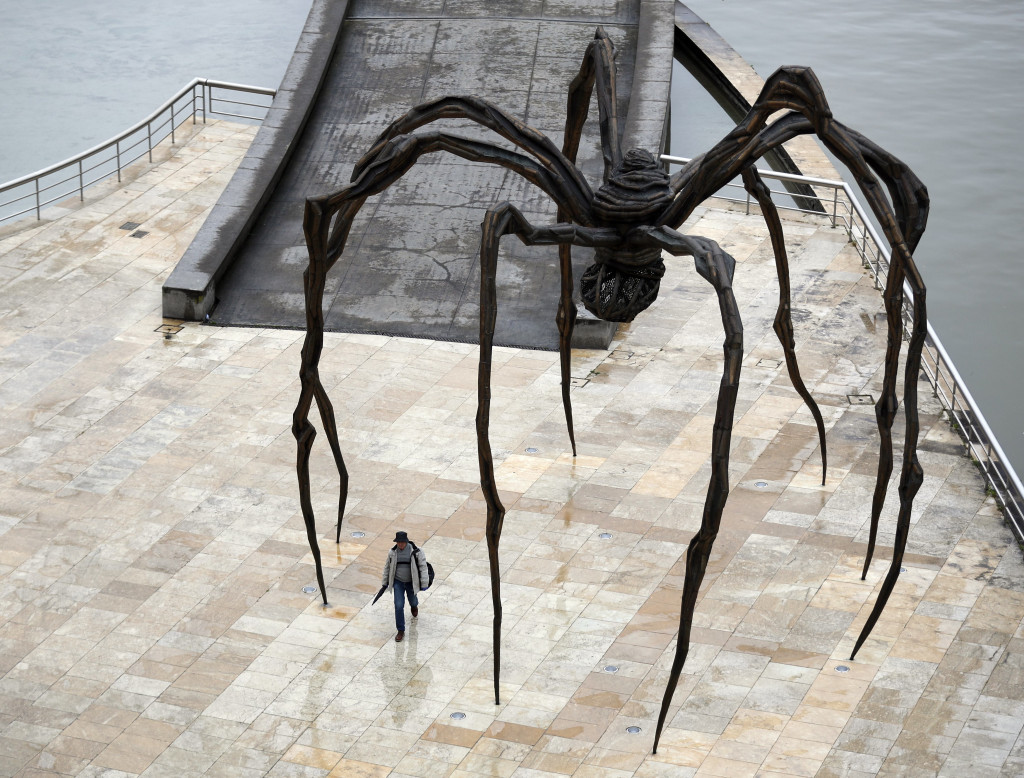[ad_1]
Louise Bourgeois’s art took many different forms, and it often explored topics such as memory, sex, and trauma. But the works that have come to define the late artist’s career are her sculptures of spiders, some of which tower 30 feet into the air and menacingly loom over viewers’ heads. Below is a guide to Bourgeois’s sculptural practice and why later in her life she chose the spider as the subject of her work.
Childhood traumas and early-career experiments laid the groundwork for the spiders.
Born in Paris in 1911, Bourgeois began making drawings for her parents’ tapestry restoration business early on. She often recalled that, as a child, she became aware that her father was leading an affair with her tutor. After studying at Paris’s most important art schools, she moved to New York in 1938 to study at the Art Students League. While her earliest pieces were paintings and prints, she would begin creating sculptures in the 1940s, focusing first on wood works and laying the groundwork for her spider sculptures decades later.
In 1949, Bourgeois had a solo show dedicated to her sculptures at Peridot Gallery in New York. The exhibition featured her wooden “Personnages” sculptures, which she created from 1945 to 1955. These slender abstract works each possess idiosyncratic characteristics like curves and crevices. The artist said that such works served as vehicles through which she grappled with memories of people from her childhood and early life in Paris—comments that foreshadow ones she would later make about her spiders.

Paul Cooper/Shutterstock
In the following decades, Bourgeois’s work expanded dramatically in scale.
After her first New York solo show, Bourgeois continued pushing her art in new directions. In the 1950s, spirals began appearing frequently in her sculptures. She once described the twisting form, which would become a central motif in many of her later sculptures, prints, and paintings, as a representation of “control and freedom” for her. The artist began using materials like bronze, plaster, and marble in the 1960s to make sculptures based on human anatomy, from limbs and breasts to genitalia.
These works wound up establishing the sense of disquiet and uncanniness that would be felt in much of Bourgeois’s art thereafter. With the series “Cells,” which Bourgeois began creating in 1989, several years after her 1982 retrospective at the Museum of Modern Art, the artist addressed the notion of entrapment. She formed impenetrable barriers with her caged environments containing sculptures and sundry items like furniture, tapestries, and clothing. These psychologically fraught sculptures are meant to envision states of isolation.

Will Oliver/EPA/Shutterstock
Bourgeois began creating her iconic spider sculptures toward the end of her career.
Bourgeois started crafting her famed steel spider sculptures in the 1990s. The artist had previously experimented with arachnid forms in two ink and charcoal drawings made in 1947, but her sculptural series would take those ideas to a monumental scale. Perhaps influenced in part by her early years at the tapestry restoration business, Bourgeois once explained that she chose the spider as a subject because its traits reminded her of her mother. “She was deliberate, clever, patient, soothing, reasonable, dainty, subtle, indispensable, neat, and as useful as a spider,” the artist said.
Maman, which was created for the grand opening of Tate Modern in London in 2000 and remains in the institution’s collection, is the biggest of Bourgeois’s spiders. Visitors can navigate around the creature’s eight splayed legs and peer up at its body, an elegant knot of coiling forms. Under its body, the large-scale spider carries a sac of marble eggs. One of six bronze casts of the original steel work stands grandly in an exterior plaza at the Guggenheim Bilbao in Spain. Editions of Maman can also be found in the collections of the National Gallery of Canada in Ottawa, the Crystal Bridges Museum of American Art in Bentonville, Arkansas, and other international institutions.

Salvatore Di Nolfi/EPA/Shutterstock
Bourgeois’s spiders remain enduring sources of intrigue for many.
Having been the subject of a public exhibition at Rockefeller Center in New York in 2001, a longterm display at the San Francisco Museum of Modern Art beginning in 2017, and many more spaces around the globe. Bourgeois created spiders of all different sizes, including small-scale brooches and overlapping networks of legs and bodies into the 2000s. A critical body of work in a long practice of exploring psychology, emotion, and the complexities of human relationships, Bourgeois’s spiders have become some of the most widely recognizable sculptures in the world.
[ad_2]
Source link

